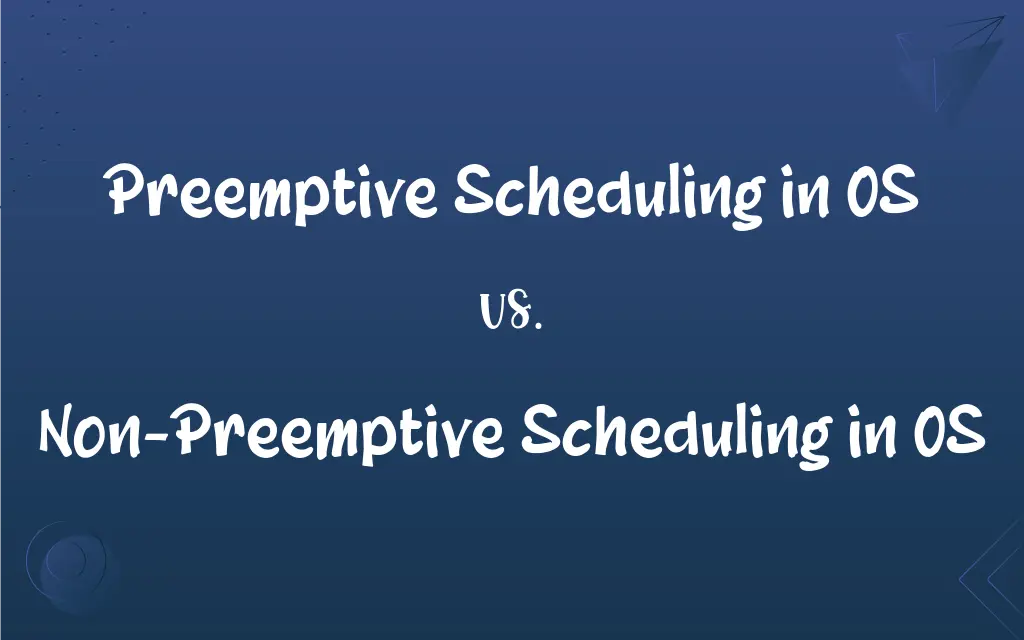Preemptive Scheduling in OS vs. Non-Preemptive Scheduling in OS: What's the Difference?
Edited by Aimie Carlson || By Harlon Moss || Published on May 12, 2024
Preemptive scheduling in OS allows interrupting a running process for another to execute, while non-preemptive scheduling completes each process before starting another.

Key Differences
Preemptive scheduling in OS is a technique where the operating system can preempt or interrupt the currently running process to start or resume another process. This method is essential for ensuring responsive and efficient multitasking, allowing high-priority processes to execute timely. In contrast, non-preemptive scheduling allows a process to run to completion or until it voluntarily yields control. This approach is simpler but can lead to longer wait times for time-sensitive processes.
With preemptive scheduling, the OS has more control over the order and duration of process execution. It can allocate CPU time based on process priority, ensuring that critical tasks are addressed promptly. Non-preemptive scheduling, however, waits for a process to complete or enter a waiting state before switching to another process, making it less flexible in handling varying process priorities.
Preemptive scheduling is suitable for systems requiring high responsiveness and real-time processing, as it can quickly switch between tasks. This can, however, lead to more complex management and potential issues like race conditions. Non-preemptive scheduling is simpler to implement and maintain, making it a good choice for systems with less critical time constraints and simpler task management needs.
In terms of resource utilization, preemptive scheduling tends to be more efficient, as it can allocate resources dynamically based on current system needs. However, this efficiency comes at the cost of higher overhead due to context switching. On the other hand, non-preemptive scheduling is less taxing on system resources in terms of context switching but can be inefficient in scenarios where processes with lower priority block more critical tasks.
Preemptive scheduling requires mechanisms to save and restore process states, which can be complex but necessary for time-sensitive applications. In contrast, non-preemptive scheduling is straightforward since processes run to completion, reducing the overhead and complexity associated with context switching.
ADVERTISEMENT
Comparison Chart
Process Interruption
Allows interrupting a running process
Runs each process to completion
Flexibility
High flexibility in process prioritization
Lower flexibility in managing priorities
Suitability
Ideal for real-time, responsive systems
Better for simpler, less critical systems
Resource Utilization
More efficient but higher overhead
Less overhead but potential inefficiency
Complexity
More complex due to context switching
Simpler, with minimal context switching
ADVERTISEMENT
Example Use Case
Time-sensitive applications, multitasking
Batch processing, less time-critical tasks
Preemptive Scheduling in OS and Non-Preemptive Scheduling in OS Definitions
Preemptive Scheduling in OS
Ensures efficient CPU utilization in multitasking environments.
Our server OS employs preemptive scheduling to optimize resource use under heavy load.
Non-Preemptive Scheduling in OS
Runs each process to completion before starting another.
Non-preemptive scheduling in the OS ensures a process finishes before another begins.
Preemptive Scheduling in OS
Suitable for real-time applications requiring immediate response.
Real-time operating systems rely on preemptive scheduling for prompt task handling.
Non-Preemptive Scheduling in OS
Simpler to implement with minimal context switching.
Our batch processing system uses non-preemptive scheduling for simplicity.
Preemptive Scheduling in OS
Prioritizes tasks based on urgency and importance.
The OS uses preemptive scheduling to manage multiple concurrent user requests.
Non-Preemptive Scheduling in OS
More predictable as processes run without interruption.
Non-preemptive scheduling offers predictability in execution order of processes.
Preemptive Scheduling in OS
Involves complex management of process states.
Preemptive scheduling requires robust algorithms for efficient context switching.
Non-Preemptive Scheduling in OS
Less suitable for time-sensitive tasks.
For applications that aren't time-critical, non-preemptive scheduling is an efficient choice.
Preemptive Scheduling in OS
Allows the OS to interrupt and switch between processes.
In preemptive scheduling, a high-priority task can interrupt a running process.
Non-Preemptive Scheduling in OS
Can lead to inefficient CPU utilization with long-running processes.
The OS’s non-preemptive scheduling sometimes leads to CPU idle time during lengthy tasks.
FAQs
Is non-preemptive scheduling simpler than preemptive?
Yes, it's simpler with minimal context switching.
Is non-preemptive scheduling suitable for real-time applications?
No, it's less ideal for real-time tasks due to lack of immediate responsiveness.
What is non-preemptive scheduling in OS?
A scheduling approach where each process runs to completion.
What is a drawback of non-preemptive scheduling?
It can lead to inefficiencies with long-running, lower-priority tasks.
How does non-preemptive scheduling affect CPU utilization?
It can lead to underutilization if high-priority tasks wait behind long ones.
Can preemptive scheduling handle high-priority tasks effectively?
Yes, it prioritizes urgent tasks by interrupting less critical ones.
What type of systems commonly use non-preemptive scheduling?
Systems with batch processing and less critical tasks.
What is preemptive scheduling in OS?
It's a scheduling method where the OS can interrupt a running process.
How does preemptive scheduling enhance multitasking?
By allowing the OS to switch between tasks for optimal resource use.
Which scheduling is better for time-sensitive systems?
Preemptive scheduling is better for time-sensitive systems.
Can preemptive scheduling lead to frequent context switching?
Yes, it can cause more frequent context switches.
Is preemptive scheduling more responsive to user input?
Yes, it's more responsive due to its ability to prioritize tasks.
How does preemptive scheduling affect task prioritization?
It allows dynamic prioritization based on task urgency.
Does preemptive scheduling require complex process management?
Yes, it involves complex context switching and state management.
What are examples of non-preemptive scheduling?
Traditional batch processing systems often use non-preemptive scheduling.
Does preemptive scheduling require more system resources?
Yes, due to the overhead of managing process states.
What are examples of preemptive scheduling?
Operating systems like Windows and Linux often use preemptive scheduling.
Is non-preemptive scheduling predictable in process execution?
Yes, it offers more predictability as processes run uninterrupted.
Can non-preemptive scheduling handle multiple user requests efficiently?
It's less efficient for systems with concurrent user requests.
Can non-preemptive scheduling lead to process starvation?
Yes, it can cause starvation if a long process blocks others.
About Author
Written by
Harlon MossHarlon is a seasoned quality moderator and accomplished content writer for Difference Wiki. An alumnus of the prestigious University of California, he earned his degree in Computer Science. Leveraging his academic background, Harlon brings a meticulous and informed perspective to his work, ensuring content accuracy and excellence.
Edited by
Aimie CarlsonAimie Carlson, holding a master's degree in English literature, is a fervent English language enthusiast. She lends her writing talents to Difference Wiki, a prominent website that specializes in comparisons, offering readers insightful analyses that both captivate and inform.







































































